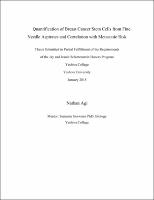Please use this identifier to cite or link to this item:
https://hdl.handle.net/20.500.12202/4176| Title: | Quantification of Breast Cancer Stem Cells from Fine Needle Aspirates and Correlation with Metastatic Risk |
| Authors: | Agi, Nathan |
| Keywords: | Stem cells --Research. Stem cells --Therapeutic use. Cancer cells --Identification. Breast --Cancer --Research. |
| Issue Date: | Jan-2015 |
| Publisher: | Yeshiva College |
| Abstract: | Why do cancers relapse? For decades, scientific thinking saw relapse solely as an extension of drug resistance. Cancer is, fundamentally, a disease of uncontrolled cell growth—a characteristic that also imparts cancer cells with an elevated rate of genetic mutation. When chemotherapy and radiation are administered to a patient, the cells that by chance had acquired mutations that rendered them resistant to treatment survive and spawn descendants that are similarly resistant to treatment. Thus, relapse was understood as a byproduct of Darwinian natural selection, where certain cells develop chance mutations that favor their survival when the selective pressure of drug and radiation treatment is applied. By this account, any cancer cell, if it acquires the “right” chance mutations, can yield progeny that define a clinical relapse. Yet this theory, while powerful, seemed incomplete. If this were true, why would treating a recurrent cancer with the same drug lead to a second remission, as happens in some cases? Recent decades have seen the emergence of a new facet to the answer of why cancers relapse. This research posits that relapse is driven by a specific cell type that possesses the unique ability to drive tumor growth and resist treatment. Thus, rather than envisioning cancer as a mass of cells, each of which has equal probability of spawning new tumors, this account posits that the ability to spawn tumors is unique to a distinct cell type—the cancer stem cells. These “cancer stem cells” have emerged as a new target in the fight against cancer. Towards the goal of developing new therapies that specifically target this unique cell type, it is important to develop means of assessing their representation in a given tumor—by quantity and marker expression—so that personalized treatment plans can be applied to particular patients. We have developed efficient and minimally invasive techniques to quantify the representation of these “cancer stem cells”, and have determined that the results of these quantification techniques have prognostic value—that is, such data may be used to predict the level of risk for a particular tumor in a particular patient to spread throughout the body. Since this spread of cancer throughout the body, called metastasis, is responsible for approximately 90% of cancer deaths, identifying those tumors that are at an elevated risk of metastasis at an early stage can potentially help clinicians provide personalized care to their patients. |
| Description: | The file is restricted for YU community access only. |
| URI: | https://hdl.handle.net/20.500.12202/4176 https://ezproxy.yu.edu/login?url=https://repository.yu.edu/handle/20.500.12202/4176 |
| Appears in Collections: | Jay and Jeanie Schottenstein Honors Student Theses |
Files in This Item:
| File | Description | Size | Format | |
|---|---|---|---|---|
| Nathan-Agi.pdf Restricted Access | 1.76 MB | Adobe PDF |  View/Open |
This item is licensed under a Creative Commons License

